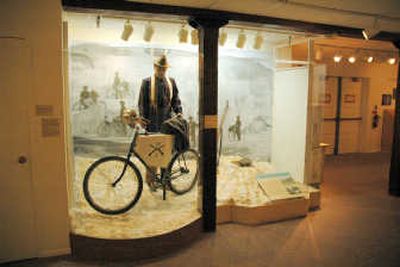Fort Missoula Museum preserves much more than military past

Fort Missoula and Fort Sherman were linked by way of the Mullan Trail back in the 1870s. The Fort Missoula Museum offers a glimpse of what life was like in those youthful frontier towns of Coeur d’Alene and Missoula and the surrounding areas. You might be surprised at what was going on in our neighboring town to the east.
If you’re interested in history, this site will grab hold of you. This is not just about an early military installation. The museum has preserved the stories that dominate the area’s industry (lumber), religion (black robes), education, U. S. Forest Service, railroads, Civilian Conservation Corps, World War II Italian and Japanese internment camps, and military history. There is a scattered assortment of old buildings on the grounds, most in log cabin design. Nearly all of them were moved onto the grounds but they are from the Western Montana region. Each contains a different display of local history.
Settlers had started to move into the Missoula Valley and had heard of the Indian “problems” to the west. They wanted protection from the U.S. military. Because of the unrest of the Nez Perce and other tribes, a military fort was built in 1878. Only three of the original fort buildings remain. The brick-walled quartermaster building is the center and headquarters for the Fort Missoula Museum. Inside, fort exhibits, including a new addition, display the interesting and numerous uses the fort had.
The 25th Infantry from back East was assigned to Fort Missoula. The 25th had several distinctions that separated them from the usual frontier detachment. First, they were all-black with white officers. It was recorded that the citizens of early-day Missoula were delighted with the neighboring military presence. Second, as an experiment, the soldier were issued bicycles to determine if this mode of transportation could be used by the military. They packed their full field gear onto the bikes and rode them north to the St. Ignatius Mission and east to Yellowstone National Park. As a final experiment and ordeal, they rode (mostly carried) their bikes to St Louis, Mo. The bicycle was determined to not be effective on the western frontier (get a horse) and the 25th Infantry was sent back to Fort Missoula by train in a cattle car.
Although Indian uprisings turned out to be not much of a problem in the area, the fort buildings and grounds were used extensively for the next 100 years. The fort was used for training World War I recruits and was a center of operations for the Civilian Conservation Corps during the 1930 Depression years. Just before and during World War II, the grounds housed more than 1,000 Italian merchant marines that were captured and detained from eastern shipping ports. Also, more than 1,000 American Japanese were escorted from the West Coast to buildings on the fort grounds and detained for the duration of the war.
A former delivery driver to the fort remembers the obvious cultural differences between the two groups of prisoners. There were no barriers or fences separating the groups but both the Italians and Japanese stayed in their own section of the fort grounds. When a delivery truck arrived to be unloaded, the Italians would mob it. In contrast, the Japanese were much more disciplined and would wait in line to unload the truck.
Now, outside the quartermaster’s building and museum is extensive open grounds with numerous historic buildings. For older visitors, a large teepee burner will bring back memories of the numerous burners found at nearly all lumber mills throughout North Idaho. The teepees were used to burn the mountains of sawdust produced by cutting logs. Clean-air laws and new technology that could use the saw dust eliminated the teepee’s use and presence.
Missoula, like North Idaho, was dominated by the timber industry. A Forestry Interpretive Area on the museum grounds displays a rare Shay-type engine with its distinctive large smokestack that was common in the lumber camps. There are logging flat cars, a log-loading jammer, shuttle car, wagons and a working saw mill. Also, a fire lookout tower has been moved onto the grounds. Visitors are invited to climb to the top and inspect a fully equipped fire lookout, overlooking the fort and the distant mountains.
There are no reproductions or reconstructions – all the buildings are original and have been moved onto the site. A one-room school, several cabins, a log-style mission built in 1863 all contain exhibits and can be entered.
The Fort Missoula Museum is funded permanently largely by a tax levied on the local community. Their commitment to preserving regional history provides an excellent example how we have progressed in the last 150 years. Walk the 32-acre park with its 13 historic structures for a historical experience demonstrating what life used to be and look like in Western Montana and North Idaho. Thank you Missoula for the memories.